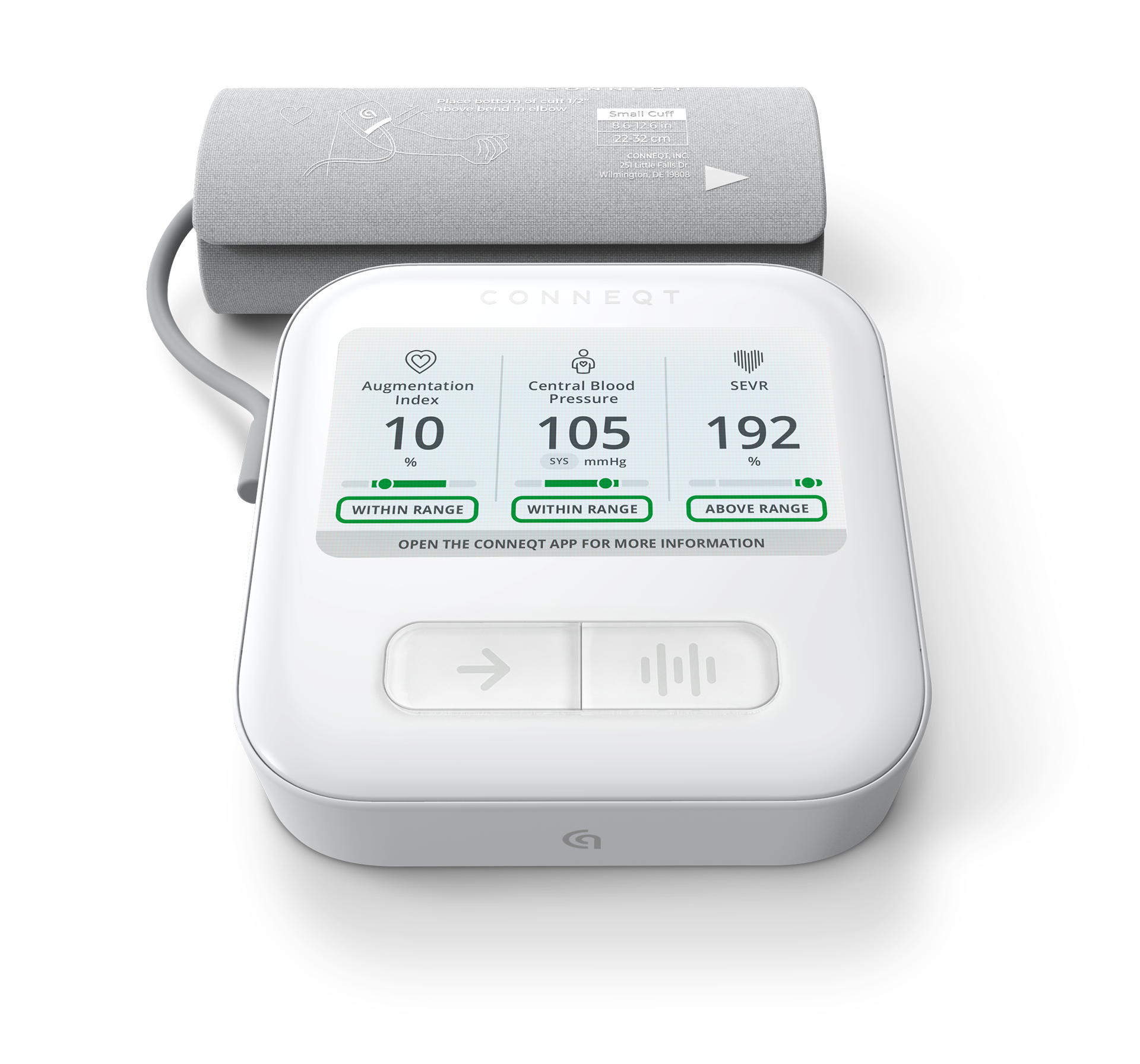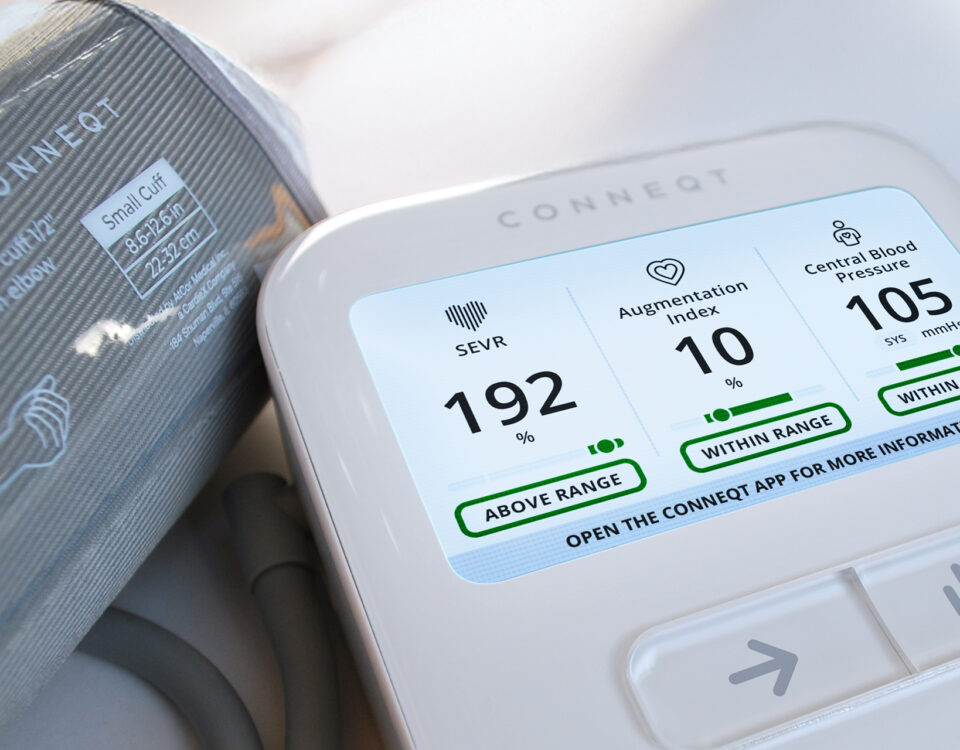The Pulse is more than just a blood pressure monitor; it’s a comprehensive health tool designed to give you deeper insights into your cardiovascular health. By tracking critical metrics, such as central blood pressure, arterial stiffness, heart stress, and heart rate, the Pulse empowers you to take proactive steps toward better heart health. In this guide, we’ll break down the key metrics the Pulse measures and explain why they matter for your overall well-being.
Central Blood Pressure (CBP)
What is Central Blood Pressure?

Measure what matters
Save 20% on checkout with code VITALITY
Central blood pressure (CBP) refers to the systolic pressure in the aorta (the main artery where blood is pumped into directly from the heart). CBP is the maximum pressure the heart and major organs face and differs from the measured brachial systolic pressure at the arm by up to 40 mmHg.
Why it Matters
Measuring CBP in conjunction with brachial blood pressure gives a more complete picture of arterial health and heart health. When CBP is elevated above 130 mmHg, studies show a threefold increase in risk of cardiovascular events such as heart attack, stroke, heart failure, and cardiovascular death. Even modest reductions are powerful—a 4 mmHg decrease in central pressure can reduce risk by about 20%.
Central Pulse Pressure (CPP)
What is Central Pulse Pressure?
Central pulse pressure (CPP) is the difference between central systolic and diastolic pressures.
Why it Matters
The higher the central pulse pressure, the greater the load on the heart and the impact on vital organs such as the brain and kidneys. A value above 50 mmHg is linked with a 2–3 times higher risk of cardiovascular events. Elevated CPP is an early indicator of vascular aging, as it indicates more force hitting your organs with each heartbeat.
Pulse Pressure Amplification (PPA)
What is Pulse Pressure Amplification?
Pulse pressure amplification (PPA) is the difference between pulse pressure measured near the heart and at the arm. Healthy, elastic arteries “amplify” the pressure as blood moves outward, while stiffer arteries reduce amplification.
Why it Matters
A PPA below 130% is considered abnormal and is linked with a twofold to threefold increase in cardiovascular event risk. Low PPA indicates early arterial stiffening and accelerated vascular aging. Sometimes brachial and central pressures tell different stories—if brachial pressure looks high but central is lower, that can reflect healthy amplification. But when amplification is reduced, your arteries are no longer cushioning pressure effectively, placing more strain on the heart.
Augmentation Pressure (AP)
What is Augmentation Pressure?
Augmentation pressure (AP) refers to the increase in central aortic blood pressure after its initial peak in systole. The increase is caused by pressure wave reflection where the pressure reflected back from branching points in the arteries comes back to the heart. An increase in AP occurs when stiffened arteries send reflected pressure back more rapidly. The Pulse separately measures both AP and AIx. AP measures the absolute increase in pressure while AIx normalizes this value relative to overall blood pressure and heart rate. Taken together, they enhance the prediction of cardiovascular risk.
Why it Matters
Healthy arteries cushion and absorb the pressure of each beat. As arteries stiffen, this cushioning fades and more pressure reflects back toward the heart. Every 10 mmHg increase in AP is associated with about a 30% increase in cardiovascular event risk. Elevated AP is a direct signal of arterial stiffness and accelerated vascular aging.
Augmentation Index (AIx)
What is Augmentation Index?
Augmentation index (AIx) assesses the increased pressure relative to the central pulse pressure. It is an indirect measure of arterial stiffness, increasing with age and reflecting the added load on the heart.
The Pulse separately measures AIx and AP to provide a full assessment of arterial stiffness.
Why it Matters
Each 10% increase in augmentation index is associated with a 35–40% higher risk of cardiovascular events. A higher AIx means a greater proportion of the heart’s workload is consumed by reflected waves, forcing the heart to work harder over time. This chronic load contributes to thickening of the heart muscle and increases the risk of heart failure. Because arterial stiffness is a modifiable process, tracking it over time is important. Studies have shown that stiffness can be reduced with therapies such as ACE-inhibitors, calcium channel blockers, statins, PCSK9 inhibitors, and SGLT2 inhibitors.
Heart Rate
What is Heart Rate?
Heart Rate is the number of heartbeats (or contractions) per minute. The CONNEQT Pulse offers users accurate heart rate measurements similar to those from an electrocardiogram.
Why it Matters
Monitoring heart rate is a key measure of cardiovascular system function. Persistently elevated resting heart rates are associated with higher cardiovascular and all-cause mortality risk. Tracking heart rate trends gives valuable context for stress, recovery, and overall cardiovascular performance.
SEVR (Subendocardial Viability Ratio)
What is SEVR?
Subendocardial Viability Ratio (SEVR) is an index of the oxygen supply to the inner heart muscle (endocardium). It reflects the balance between blood flow to the heart muscle and the heart’s oxygen demand.
Why it Matters
A lower SEVR means the heart muscle may not receive enough oxygen to meet demand, especially during exertion. This can increase risk for ischemia, arrhythmias, and long-term heart dysfunction. Understanding SEVR provides unique insights into the resilience of your heart beyond traditional blood pressure readings.
Brachial Blood Pressure
What is Brachial Blood Pressure?
Brachial Blood Pressure is the pressure on the brachial artery in the upper arm. It is represented by two numbers: systolic (the maximum pressure when the heart pumps) and diastolic (the minimum pressure when the heart fills).
Why it Matters
High brachial blood pressure is one of the most significant risk factors for cardiovascular disease. According to the American Heart Association, nearly 120 million U.S. adults (about 47%) are hypertensive, but only 24% have their blood pressure under control. Left untreated, hypertension can damage the heart, brain, and kidneys and lead to life-threatening events such as heart attack and stroke.






